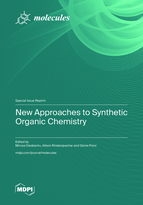New Approaches to Synthetic Organic Chemistry
A special issue of Molecules (ISSN 1420-3049). This special issue belongs to the section "Organic Chemistry".
Deadline for manuscript submissions: closed (31 March 2023) | Viewed by 20407
Special Issue Editors
Interests: organic chemistry synthesis; heterocyclic chemistry; medicinal and pharmaceutical chemistry; nuclear magnetic resonance; natural product chemistry; organometallics; dendritic chemistry; stereochemistry
Special Issues, Collections and Topics in MDPI journals
Interests: heterocyclic chemistry; medicinal chemistry; natural products; fragrance and flavor chemistry
Special Issues, Collections and Topics in MDPI journals
Special Issue Information
Dear Colleagues,
“New Approaches to Synthetic Organic Chemistry” continue to challenge and expand our scientific knowledge of the world, exploring the frontiers between at least two interfaces: human life and the environment. In this view, the two current conceptual approaches (namely, “covalent” vs. “non-covalent” synthesis) refer to all types of molecules, from the smallest ones to highly 2(3)D elaborate (supramolecular) nano-architectures (dendrimers, MOFs, COFs, etc.), including the still “exotic” molecular machines. In all its facets, the perpetually reimagined developments within current organic synthesis (strategies, methodologies, reaction mechanisms, reagents, catalysts, chemical and instrumental auxiliaries, etc.) have adopted a crucial “common denominator”—that is, “selectivity” (e.g., chemo-, regio- or stereo-selectivity)—as a mandatory criterion. The present Special Issue intends to gather original research articles, communications, and review papers disclosing the most recent advances in organic synthesis, that is, those related to its near future defined as “atomic precision” in chemical reactions. The sustainability of these efforts, which denotes an intrinsic chemical diversity, is expected to highlight their innovative applications to human life and the environment.
Dr. Mircea Darabantu
Dr. Alison Rinderspacher
Dr. Gloria Proni
Guest Editors
Manuscript Submission Information
Manuscripts should be submitted online at www.mdpi.com by registering and logging in to this website. Once you are registered, click here to go to the submission form. Manuscripts can be submitted until the deadline. All submissions that pass pre-check are peer-reviewed. Accepted papers will be published continuously in the journal (as soon as accepted) and will be listed together on the special issue website. Research articles, review articles as well as short communications are invited. For planned papers, a title and short abstract (about 100 words) can be sent to the Editorial Office for announcement on this website.
Submitted manuscripts should not have been published previously, nor be under consideration for publication elsewhere (except conference proceedings papers). All manuscripts are thoroughly refereed through a single-blind peer-review process. A guide for authors and other relevant information for submission of manuscripts is available on the Instructions for Authors page. Molecules is an international peer-reviewed open access semimonthly journal published by MDPI.
Please visit the Instructions for Authors page before submitting a manuscript. The Article Processing Charge (APC) for publication in this open access journal is 2700 CHF (Swiss Francs). Submitted papers should be well formatted and use good English. Authors may use MDPI's English editing service prior to publication or during author revisions.
Keywords
- biomimetics and new chemical entities (NCEs)
- domino reactions
- “intelligent” molecules
- iterative synthesis
- multicomponent reactions
- organic (nano)materials
- organo-catalytic systems
- selective processes
- total synthesis
- unconventional methods and techniques







